Archive for ‘Podcasts’ Category
Take Note: Paper Doll’s Guide to Organized Note-Taking for Learning and Creative Projects (Part 3)
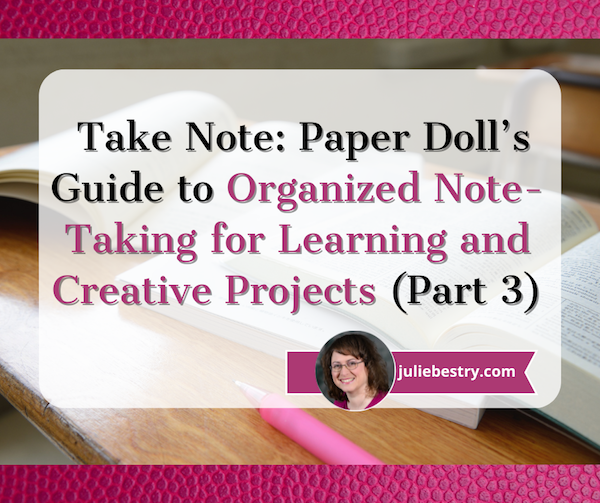
Two weeks ago, in Take Note: Paper Doll’s Guide to Organized Note-Taking (Part 1), we looked at the wide variety of situations in which you might take notes, and took a side journey into the relative merits of handwritten vs. digital notes.
Last week, in Take Note: Paper Doll’s Guide to Organized Note-Taking in Lectures & Presentations (Part 2), we explored solutions for taking notes when someone is imparting information to you verbally: in class, watching a webinar, attending a conference, and in collaborative meetings. Some variation on these methods work for casual note-taking situations, like when you’re learning about a diagnosis or treatment, you’re hearing about a new program at a PTA meeting, or even when you’re fielding information on a phone call.)
Whether you want to capture information for a later test, to improve your professional (or passion project) success, or help your team hit its action items, taking notes ensures that information can be captured, processed, learned, and acted upon.
Using my colleague Linda Samuels’ rubric, we looked at how to “listen, capture, and engage” with information using text-based note-taking (e.g., the sentence method, outlining, and the Cornell Note-Taking Method) and visual note-taking (e.g., mind mapping and sketchnoting).
We also harkened back to the idea that not all note-taking depends on information coming to you verbally. When you’re studying printed material as part of coursework, doing academic research (like a term paper on Alexander Hamilton) or writing a non-fiction book (like the history of sandwiches), you will need to take notes on what other people have written to achieve your goals.
You may also create notes from scratch, not based on someone else’s concepts (presented verbally or in writing), but invent something totally new with the help of the elves in your brain. You might write the score for a Broadway musical, engineer the schematics for a cool invention you aim to patent, or draft a novel about vampires from Jupiter or grandmother protesting injustice, or vampire grandmothers…
With modifications, you can take notes using the methods we discussed last week, but there are also note-taking methods that help you create and organize notes on non-verbal content.
ANNOTATION
Picture yourself studying for an exam or preparing to give a speech to your colleagues. However much material you already know, there’s going to be a larger chunk of the unknown printed in books, journal articles, and online.
The advantage of taking notes on what you’re reading is that you can take it at whatever speed you need to make sense of the information and organize it, combined with your own thoughts, without having all the inbound knowledge outpace you. The main disadvantage is that, unlike when a speaker accents what’s important (with voice, body language, or saying, “Hey, you numbskulls, this is going to be on the tests!”), text may not give you a clue as to what is vital.
Sure, textbooks may have concepts in bold or italics, but novels will not; if you’re reading the Federalist Papers, there’s no formatting to clue you in on what Alexander Hamilton (yes, him again!) thought was key. And if you’re researching to support your creative endeavors, only you know what will hit the spot.
Key Benefits of Annotating
Annotating enhances comprehension by allowing you to actively engage with the text, identify key points (either what the writer thinks is key or what is key for your purposes), ask yourself questions (so you can find answers in the text or in other resources), and record your own thoughts.
Annotation can lead to a deeper understanding of the printed word, making it easier to recall information later and prepare for discussions, writing assignments, or drafts. Annotating your notes reaps the following benefits:
- Improved comprehension — By highlighting important information and adding notes, you’re forced to actively process the text, leading to better understanding and retention.
- Critical thinking — Annotating pushes you to question the author’s arguments, identify biases, and form your own interpretations. In fact, as described in the New York Times article, How Students and Teachers Benefit From Students Annotating Their Own Writing, annotating improves metacognition, or thinking about how you think about something.
- Active engagement —The very act of writing notes as you read encourages focused attention and deeper engagement with the material. You’re less likely to let your eyes glaze over if you’re annotating the material.
- Organization of ideas — Annotations can help you identify the main points, structure of the text, and see how different concepts relate to one another. Sometimes it happens as you are annotating; other times, the act of annotating creates the magic that helps you see how things are connected later. If you’ve ever seen the TV show The Good Doctor, this is the way we see Dr. Shaun Murphy arriving at life-saving connections.
- Customization — You can add your own thoughts, reactions, and connections to the text, making the reading experience more meaningful. Whether you’re studying for a test or bringing concepts together to write a book, you can add your own metaphors or connections (and references to pop culture!) to make it resonate.
- Preparation for writing — Annotations are first drafts. They’re the key to making someone else’s first line of research into a foundation for your own work, whether you’re writing essays for Medium, research papers for a class, or a work project where you need to analyze and synthesize information from varied sources.
Analog Methods of Annotating
Marginalia
If you’ve ever scribbled notes, comments, or questions in the margins of a book, you’ve been annotating. You’ve done the active reading and critical thinking referenced above, and created a personal dialogue with the author of which only you are aware. (That’s OK, some authors are cranky and don’t welcome questions.)
Marginalia are great for when you want a quick reference for future review of the material. Last week, I was in a book club Zoom for the National Association of Productivity and Organizing Professionals’ Authorship and Publishing Special Interest Group (no surprise, we call it the NAPO A&P SIG), discussing On Writing Well: The Classic Guide to Writing Non-Fiction by William Zinsser.
Our leader, my colleague Deborah Kawashima, had extensive marginalia, and used those notes to lead the discussion — and to find related material when members brought up points.
I can’t bring myself to write in books — my first job was working in a library, and books are so sacrosanct to me, I can’t bear to even make a pencil notation. I use sticky tape flags combined with handwritten notebook pages for the short term (like a book discussion) and either handwritten or digital notes when working on a blog post or book project.
Take Note: Paper Doll’s Guide to Organized Note-Taking (Part 1)

Have you ever seen a sign with the letters “N.B.” on it or a set of instructions where the highlighted part says N.B.?
N.B. is short for nota bene, the Latin for “note well,” or in our own vernacular, “Hey, take note!” and until about thirty years ago, it was common to see N.B. on documents, notices, and signs, warning that something was important.

The Maryland Gazette (March 19, 1801). “Wanted, A Wife (Advertisement, Extra)” Public Domain Link
We may not use the Latin abbreviation much anymore, but we sure do have a lot of things to which we need to pay attention, or pay heed, or take note! Today, we’re going to look at different areas of our lives in which we need to capture and organize information by taking notes.
The inspiration for today’s post was friend-of-the-blog Dr. Frank Buck. Recently, I sat down again with Frank for his fabulous podcast Get Organized!, to talk about note-taking in all of its myriad forms.
In the episode entitled, Your Note-taking Just Got Better (with Julie Bestry), Frank and I chatted about the evolution of note-taking from the structured forms we learn in school to the various ad hoc and formal notes we use in adulthood, and we explored the importance of adapting our note-taking strategies to our individual needs and contexts.
I espoused my personal preference for analog note-taking (on my beloved purple Roaring Springs Enviroshads legal pads) in client sessions, both for the tactile engagement as well as how it helps me ensure my clients feel that I am focusing on them.
Paper Doll’s Thanksgiving Week Organizing and Productivity Buffet
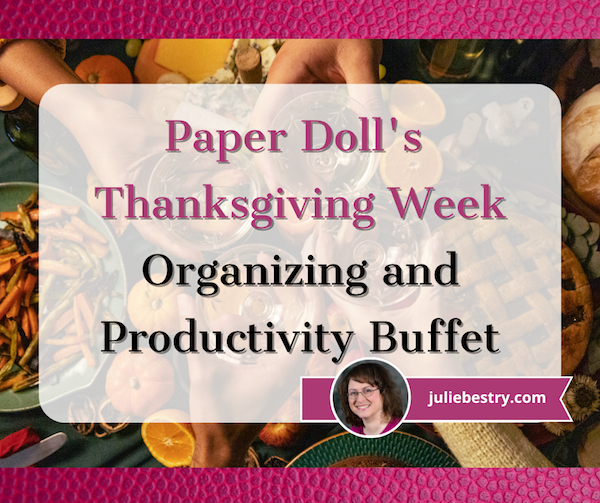
Whether you’re getting ready to go over the river and through the woods, hosting a Thanksgiving celebration of your own, or stuck (in an airport or at home) with too little to do, today’s post is for you.
I’ve created a Thanksgiving buffet from which you can take some tastes and figure out what you like. Decide for yourself whether to categorize any of these as appetizers, entrées, sides, or desserts. There’s nothing serious to require your deep attention, so just nibble as though you were sneaking through the kitchen on your way to watch the parade.
GRATITUDE AND A FOLLOW-UP ON THE CAR THEFT
If you read my August post, Organize to Prevent (or Recover From) a Car Theft, you know that I was a victim of the Kia Boys, young miscreants across the United States who steal KIAs and Hyundais, not for financial gain but for “street cred” or thrills. It’s my philosophy that almost anything bad from which you recover makes a good anecdote (or blog post), but the lesson of preventing car thefts and recovering from them is one I’d have preferred to research online rather than personally experience.
The indignities of being a victim of theft did not stop with the recovery of my little red PaperDollmobile. Due to a turf war between towing companies, miscommunication at the body shop, an utter failure of professionalism on the part of someone we’ll call the Jerky Insurance Dude, and a series of back-ordered parts (mostly due to the mass of Kia and Hyundai thefts nationwide), it took two months for my car to be repaired and returned.

Just a few weeks ago, the federal judge who initially refused to approve the $200 million class action settlement against Kia and Hyundai because it wasn’t supportive enough of victims has acknowledged the revisions to the settlement and approved it. It will likely be years before we victims see those compensatory funds (almost certainly be reduced by attorney and court costs), but the resolution is something else for which I can be thankful.
Meanwhile, if you haven’t read the original post, or if you’d like to hear more of the updates, or if you just prefer a good chatty tale, friend-of-the-blog Dr. Frank Buck recently had me on his podcast in an episode entitled From Chaos to Clarity: A Professional Organizer’s Car Theft Journey.
Frank and I discussed many of the concepts in my blog post, but also expanded upon teh experience. We talked about handling the unexpected, and how to deal with shock of a situation but still capture the essential information in order to survive and get to the other side. Professionally and personally, Frank and I can attest to the essential role of good note taking during any emergency or catastrophe.
If you watch the podcast on video, above, and please leave a comment or “like” on Frank’s YouTube page. Or, if you’re driving somewhere this week and need to drown out the “Are we there yet?” whines punctuated by kicks to the back of your seat, you can listen to my episode of Frank’s podcast on Apple Podcasts, Google Podcasts, Spotify, Overcast, Castbox, and pretty much wherever you get your pumpkin-spiced podcasty goodness.
HOW TO SHOW GRATITUDE FOR OUR BOUNTY
“There is no product or service more ecological, sustainable and recyclable as the one we do not use.”
— Philippe Bihouix, engineer and author of The Age of Low Tech: Towards a Technologically Sustainable Civilization
This quote, included in Sunday’s Cool Tools Lab’s Recommendo newsletter, was certainly well-timed.
What a perfect way to show gratitude for the bounty in your life by using the week ahead to identify what you’re not using or wearing and earmark those items for donation.
Thanksgiving is an ideal time to discuss with your children the concept that not everyone has as much, and help them consider the toys and games they’re no longer enjoying. It’s a great way to be responsible to the planet, their fellow humans, and their own home.
And what better way to teach your children than by example?
Last Friday, I gave one of my signature speeches detailing all the reasons why it’s difficult to let go of possessions. I talk about how we sit on our “Buts” (one T) as in, “I’d let go of it…but it was expensive.” Or, “I’d let go of it, but it was a gift.” In part of that presentation, I noted that one of the big “buts” in letting go of excess is “But I want to find the perfect home before letting go.”
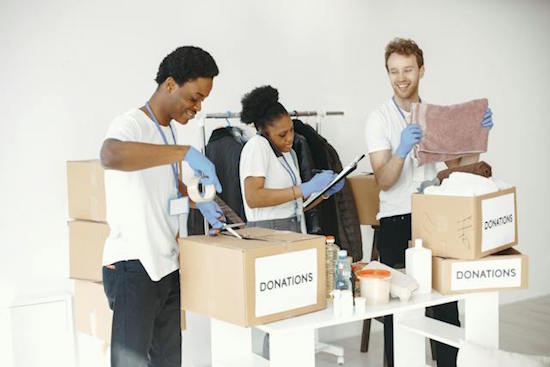
People Working at Donation Center Photo by Gustavo Fring via Pexels
We hate spending the time, money, and effort to keep what we don’t want or need, but we hate the idea of “wasting” perfectly good items more, as if languishing in OUR basement is a better fate for something than ending up with (an unknown) someone whose worth we can’t know or judge.
So, we decide that as soon as we find the perfect place for an unused table to go, we’ll send it on its way, but either we don’t know about available resources (like a furniture bank or Habitat for Humanity’s Restore) or we never go all the way from making the decision to actually getting it out of our homes. Take comfort that whether you recycle, donate, or sell, letting go of what you never use has three benefits. It means a good home for the item, joy for the new owner, and more space for you.
As we say in professional organizing, done is better than perfect!
GET CRAFTY ABOUT REDUCING YOUR CRAFT STASH
Speaking of getting rid of excess for purposes of sustainability, my fabulous friend and colleague Janice Simon of The Clutter Princess brought my attention to a nifty option for all of you crafty (and aspiringly crafty) folks.
Destashify is your resource for letting go of the excess cloth- and needlework-adjacent craft supplies you have on hand. It’s a bit of crafting thrift shop. In their words: Destashify is dedicated to keeping sewing, quilting, knitting, crochet, and other wearable art supplies out of landfills.
Destashify will sell, recycle, or donate your excess crafting supplies to individuals or organizations who will make use of you letting them instead of letting them pile up in the corner.
Obviously, if you actively work on your crafts, nobody would encourage you to stop. But if you have piles of these kinds of supplies, either in your own space or the space of someone you have responsibility for maintaining, Destashify offers a few nifty options.

Destashify, Filtered for Purple Yarn
Sort through your materials and collect any unwanted fabric, patterns, yarn, trim, and notions. If you have books, magazines, or DVDs on sewing, quilting, or related crafts, as well as patterns or even machinery (like sewing machines, accessories, and software), add them to your outgoing stack. Now, you have two options.
Sell Your Craft Supplies via Destashify
If you sew, quilt, knit, or are otherwise a “fiber artist,” you can destash (that is, declutter your stash), start a side hustle to fund your hobbies or life, or expand any craft-related existing business with a new outlet.
- Create a Destashify seller’s account and list your items for sale.
- Fulfill orders made through the Destashify site.
- Receive payment through either Venmo or Paypal.
Destashify charges no up-front costs to sellers. If you sell supplies via Destashify, they keep $1 + 15% of the remaining product subtotal. Beyond that, they charge no extra listing fees or payment transaction fees. If any of your items fail to sell, they won’t charge you anything for the listing (or re-listing). Buyers pay one flat fee for shipping, and sellers retain 100% of the shipping fee, but are responsible for the actual shipping costs.
Donate Your Craft Supplies to Destashify
If you donate your craft supplies, Destashify will pay for the shipping! (Note: Destashify is not a 501(c)(3), so you can’t deduct the value of your donation on your taxes.)
Destashify may donate your donations to organizations, like schools, or sell to fund operations. As when you donate anything, make sure your supplies are in good, clean condition. They can be related to: sewing, quilting, knitting, crochet, weaving, embroidery, tatting, upholstery, and home décor. Gather them up in a box (or boxes) and then:
- Click on the “contact us” link at the bottom of every page of the Destashify page and tell them that you want to donate.
- Once you provide your shipping address and phone number, Destashify will send you prepaid shipping labels (with the information you provide as the label’s return address).
- Include the height, width, and depth dimensions, as well as the weight of each package you want to send. (Limit your shipping box dimensions to under 19 inches.)
They require a minimum of one yard of apparel fabrics or 1/4 yard for quilting fabrics. Leather, suede, and fur are accepted, as is yarn. Notions include doohickeys like thread, elastic, and grommets, while fastenings are, as you might guess, things that let you fasten clothing, like snaps, buttons, or zippers. Destashify will also accept small tools, like rulers, scissors, and awls.
However, they are unable to accept donations that are heavy or oversized, requiring excess storage space or egregious shipping costs. So, please don’t donate big storage or furniture items like cabinets or sewing tables, nor heavy machines like sewing machines or sergers. (You can list them for sale through Destashify, though!)
Watch two of the Destashify-ers talk about craft donation hauls here.
Destashify is a young venture, so they currently only support U.S.-based sellers; they are able to ship to buyers in Canada and the United Kingdom.
Finally, if your craft area is nicely pared down and organized, and you’re interested in buying from Destashify, just click on any menu and use the left-side panel to filter for things like color families, fabric types, fibers, patterns, garments and garment types, weights, and more.
PUT THE KIBOSH ON COAT CLOSET KERFUFFLES
Longtime readers of the blog know that I’m not one for recommending unnecessary products, and I don’t usually mention products that are too far afield from organizing your paper, information, and productivity. And I definitely avoid recommending products before they’re entirely on the market. However, when things come across my TikTok feed that make me sit up and take notice, I want to share them with you.
Swedish inventor and YouTuber Simone Giertz has developed Coat Hingers, and no, that’s not a typo. Giertz’s Kickstarter was seeking $50,000 to manufacture foldable hangers to allow for clutter-free storage in shallow closets and narrow spaces. In the first two days, she not only hit her goal, but exceeded it! Now, with 26 days remaining in her Kickstarter month, she’s already garnered $255,984 in pledges from 1940 backers aspiring to own the product.
Unlike the kind of foldable hangers designed to be used in luggage, Giertz found no solutions for folding hangers meant to actually be hung in closets, particularly shallow ones. So, she created her own, developing prototypes of hinged hangers.
You just put your article of clothing on the hanger, fold at the hinge, and now you’ve got the ability to store the shirt (or whatever) in half the depth.
Whereas traditional hangers measure about 17 1/2 inches, horizontally, Coat Hingers fold to take up just 9.3 horizontal inches. The hingers are made of stainless steel hangers with injection molded acetal hinges for durability.
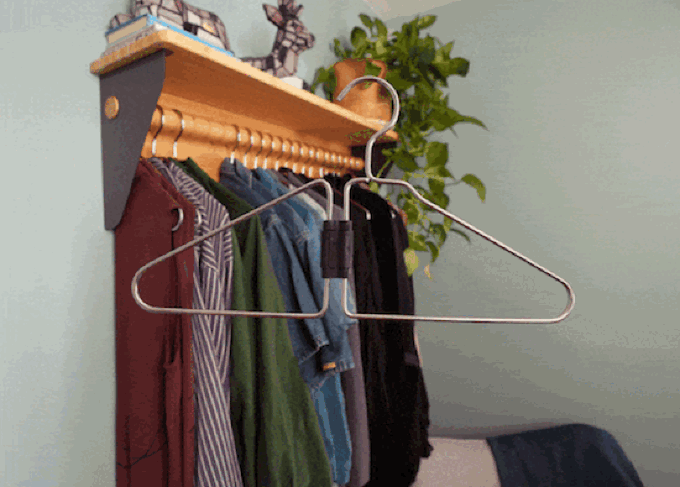
Supporting Giertz at this point is a pricey, but if you’re in a small space and are likely to be there a while, it’s worth considering. One Coat Hinger is $20, and a dozen are $75.
Because Coat Hingers need to be a certain distance from the wall, they recommend that in lieu of off-the-shelf (no pun intended) closet rods, you make the rods in their kits, which come in four different color schemes (charcoal, white, red, and green). The shelf kit is $270, while the small bracket kit is $135 and the large is $200. The shelf kit and large bracket kit come with two dozen Code Hingers; the small bracket kit comes with one dozen.

All Coat Hingers come with a set of silicone stoppers that slide along the diagonal arms of the hanger to keep items with low necklines or thin straps from sliding off of the hanger.
Unfortunately, Kickstarter videos aren’t shareable. (Why?! Social sharing would bring in so many more backers?) However, Giertz’s YouTube channel has a great video on how her product came to be that will give you a good sense of what she’s creating.
(Did you notice that it’s pronounced coat hinge-er, accenting the hinge, rather than coat hing-er to sound like hanger?)
When I was in graduate school, I lived with six other students in my program in a scary green Addams Family-esque house with squirrels in the attic. Due to the luck of the draw, I got one of the larger bedrooms, but the closet was minuscule, slightly smaller than a telephone booth, with the sole rod positioned on the diagonal. Hanging clothes in that shallow a space was almost an impossibility, as was keeping any kind of order. I would have loved Coat Hingers back in 1990!
DE-STRESS THE HOLIDAY SEASON FROM THE START
Thanksgiving is the official start of the holiday season, which means it can also be the start of the stressed-out, exhausted season as well. I’ve got two resources for you for keeping your season on an even keel.
First, the theme of Janet Barclay’s November Productivity and Organizing Carnival is Stress-Free Holidays. It includes 15 posts from my fabulous colleagues for helping you deal calmly with planning and organizing your season and getting the self-care you need.
Then, you might want to pick up a copy of my classic season-smoother, Simplify the Season and Save Your Sanity so that you can thrive, and not merely survive during the upcoming holiday season.
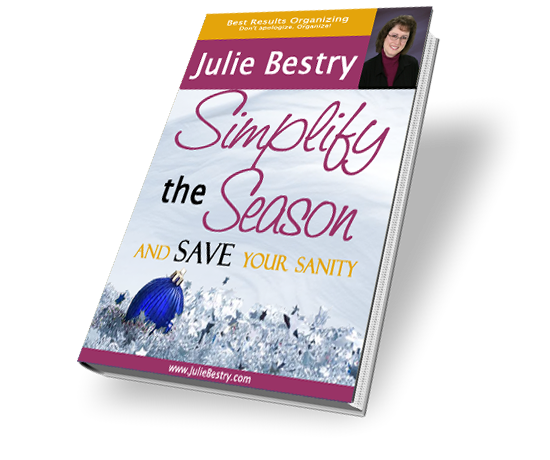
Are you so frazzled by mid-December that your nerves start to feel like tangled Christmas lights?
Have visions of sugarplums been replaced by nightmares of long lines and traffic jams?
Does that Thanksgiving turkey remind you of a time bomb, ticking down to the big day in December?
If so, Simplify the Season and Save Your Sanity may be exactly what you need.
PLAN FOR A SANE RE-ENTRY NEXT WEEK
Heading back to work after a long Thanksgiving weekend can be overwhelming, and it can be tempting to try to barrel your way through the work. However, back in October, we talked about the importance of taking time away from your desk to refresh, whether short-term or long-term.
Take a Break — How Breaks Improve Health and Productivity
Take a Break for Productivity — The International Perspective
After you revisit these posts, you may want to read this piece from The Muse, Take Five: 51 Things to Do When You Need a Break at Work.
I’d explored a variety of break options, but some readers mentioned that they often feel guilty taking breaks that “looked” lazy, as if doing healthy things for your body, brain, and spirit somehow lacked worth. (Remember Paper Doll telling you this: you are not your job or your role. Your worth does not come from what you do. It’s innate to who you are!)
The genius of this Muse post is that it offers some fun suggestions, links, and resources for digging deeply into categories of breaks that still accomplish something, in case you’re still working on accepting yourself even when you’re not entirely in worker-bee mode. The categories are:
- Energizing
- Brain-Boosting
- Social
- Productive (It won’t surprise you that this is my favorite category of tips!)
- Career-building
- Relaxing
- Downright Distracting
My favorite, given that we’ll have just come out of Thanksgiving, is #18:
Send a thank you note to someone who’s helped you out recently—your assistant who’s gone above and beyond or a co-worker who proofread a report for you. It doesn’t even have to be something big—in fact, bonus points if it’s not.
And with that, kind readers, I thank you for reading, commenting, and sharing. May you and your families and friends have safe travels and a happy, healthy Thanksgiving.
Paper Doll Interviews Motivational Wordsmith Kara Cutruzzula

Welcome back to another installment of our rare Paper Doll series of interviews with colleagues and special guests. I’ve interviewed productivity specialist Melissa Gratias, academic/life coach and inventor Leslie Josel, genealogy organizers Janine Adams, Jennifer Lava, and Hazel Thornton, and life coach/author Allison Task.
Today, I’m excited to introduce you to journalist/writer/editor/playwright/lyricist/librettist Kara Cutruzzula (rhymes with Methuselah!), friend-of-the-blog and purveyor of motivational oxygen.
We met when I subscribed to Kara’s newsletter Brass Ring Daily in 2019. She’d provided a link to a spec script she’d written for Gilmore Girls, one of my all-time favorite TV shows, and I wrote a fan-girling email to tell her how brilliant and talented she was, the subject line of which was, “My neighbor was awakened by my raucous laughter thanks to your Gilmore Girls script!” Kara’s ear for dialogue and how she made secondary and tertiary characters like Michel and Lane absolutely shine were impressive.
Paper Doll readers may initially wonder what Kara’s talent for capturing the distinct voices of characters on a hit television show has to do with organizing and productivity, the bread-and-butter topics here on this blog. But you’ll soon see — and it all started with that get-to-know-you chain of emails where Kara and I traded our insights about the process of getting things done — and the frustration of not getting things done.
it’s OK to archive that email you never responded to back in August 2021.
it’s also OK to respond! yes, today!
less OK is staring at in your inbox for another six months.
free yourself. one or the other.
— Kara Cutruzzula (@karacut) February 22, 2022
We kept finding ways to work together and support one another’s efforts. I interviewed Kara about newsletter writing and magazine editing for a monthly meeting of the NAPO Authorship & Publishing Special Interest Group and then she interviewed me for a great feature for Forge, Medium’s personal development outlet. Readers, that piece, Now Is the Right Time to Declare Bankruptcy on Your Projects, is so good, you should open it in another tab right now so you don’t forget to read it.
And Kara just interviewed me for the soon-to-premiere season #2 of her Do It Today podcast! If you find productivity compelling, or you could use a little motivation to turn your dreams into reality, get to know Kara!

EVERY SUPERHERO HAS AN ORIGIN STORY
Paper Doll: Could you tell Paper Doll readers about your early life and college years? I know you majored in English at UCLA. What did you plan to do when you finished school?
Kara Cutruzzula: Hearing this question makes me laugh because…I didn’t have a solid plan! My Big Idea was to move to New York and find a job “working with words.” (So cute!) I was applying for internships and editorial assistant jobs every day. Book publishers, magazines, websites, university presses, you name it.
A few weeks after graduating I bought a plane ticket and took advantage of the generosity of my aunts Gina and Jo by crashing on a pull-out couch in their apartment (we called it “the nook”) and crossed my fingers I would find something to do. Then I did.
This highlights something that’s come up over and over again in my career: First you leap, then you figure it out.
You have used your words to craft a set of interlocking and parallel careers. Basically, you’re a polymath (a fancy-pants way of saying Renaissance Woman). Your fascinating and diverse experience includes work as an editor, writer, newsletter creator, playwright, lyricist, and podcaster.
Did (or how did) your internships in film and TV prepare you for the career path you’ve had? How did you get your start in writing for online outlets?
In hindsight these unpaid college internships (at a film development company, at a publicity firm working on Oscar campaigns, and a B2B travel magazine) laid stepping stones for the future. I loved taking the bus (yes, I was the rare LA bus rider) to the 20th Century Fox lot to work at the film development company.
Sure, I picked up chopped salads for the executives, but I also read and wrote coverage of screenplays and TV pilots, and covered assistants’ desks when they were out of the room. (To this day, there’s still nothing scarier to me than “rolling calls” — placing and returning phone calls to intimidating execs at a lightning-fast pace!)
Working at the travel magazine was a great stroke of luck, too. The editor-in-chief, Ken, kindly set me up on an informational interview with a magazine editor when I moved to New York. No job came from that interview, but even a short getting-to-know-you meeting is a huge lift to your spirits when you’re 21 and don’t know anyone in the industry.
As for writing, if you caught me during the first five years of my career, I wouldn’t have called myself a writer at all! In 2008, I was hired as a culture intern at The Daily Beast, a then two-month-old website founded by editor Tina Brown. The team was small, maybe 15 people, and that was my real education. I helped the culture editor plan out culture coverage — what was the site going to cover and how were we going to cover it? — and transcribed interviews and contacted publicists and all sorts of other tasks.
Then I became a homepage editor. Remember, this was back in 2008. We weren’t getting traffic from social media. People actually visited a website’s homepage. As a homepage editor, you were responsible for story placement, headlines, photos, and deciding what needed coverage on the Cheat Sheet — basically “the mix,” as Tina called it. What did people want to read? (Actually, being a homepage editor was scarier than rolling calls!) But there was a real sense that what you were doing was important. You were covering the news. Everyone was incredibly invested, and the team was brilliant.
After The Daily Beast merged with Newsweek in 2010, I moved over to the magazine side to edit and assign stories for the back-of-book section covering film, TV, theater, fashion, and a back-page feature called “My Favorite Mistake,” where I interviewed James Earl Jones, Barbara Corcoran, Richard Branson, and other fun folks. But I got a crash course in magazine editing. Very different from editing for a website! You can only fit so many words on a page. I loved it.
This is a very long way of saying I was primarily an editor for four years. It was fun and rewarding and also exhausting. Newsweek published its Last Print Issue in 2012 (it’s since been resurrected) and I was laid off.
I didn’t want to work full-time at another magazine or website. (This was 2012; freelancing was a little less common than it is now.) So I thought: What else is out there?
Over the next 10 years, I became a writer.
GRABBING THE BRASS RING
You launched Brass Ring Daily in 2017. What caught my eye in those daily emails and the (now) 1000+ newsletter archive was the fact that while you were writing about disparate aspects of your own life, theater, and things that were going on in the world, you were blending motivational quotes, advice about productivity and self-empowerment, and doing it all without trying to sell anything. And Vanity Fair called it, “A life coach in your inbox.”
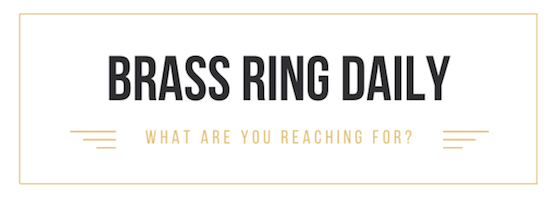
What prompted you to start the Brass Ring Daily? What has meant the most to you about the experience?
I became a freelance writer and editor — I even spent a solid three years as a travel writer — but I was also holding these monthly “summits” at my apartment where creative folks and friends would talk about projects and share resources.
[Paper Doll Editor’s Note: My late, great high school history teacher, Mr. Fred Murphy, would have wanted me to draw the parallels between Kara and Madame de Staël, an 18th- and 19th-century Frenchwoman and writer, famous for connecting the greatest minds of her era in salons.]
I took notes during these meetings so that one editor’s name or that great productivity tool was recorded for anyone who needed it. I wrote up a summit recap and sent it out to the group.
After a year or two, my friends Alison and Daphna asked if I ever thought about starting a newsletter. So…I did! And it’s the smartest thing I’ve ever done for my career and also my sense of self as a writer. I always tell people to own something for themselves, even if that something is small.
The newsletter gave me a daily deadline that wasn’t attached to an editor or assignment. I didn’t have to answer to anyone, except my own nagging guilt if I skipped a day. And it gave me a place to collect all the inspirations, book quotes, and my own thoughts on creating. The newsletter collects them and allows me to let them go — basically, it’s my most important tool for organization!
[Paper Doll Editor’s Note: Brass Ring Daily often has delightful cameos by baby animals.]
WORDS AND MUSIC: KARA’S NAME UP IN LIGHTS
You’re also a musical theater lyricist and librettist, and from your newsletter, I know you’ve worked on a wide variety of projects as part of the BMI Musical Theatre Advanced Workshop and the BMI Librettists Workshop. Can you tell readers about Letters from May and The Marvelous Mrs. Maisel Musical?
The Kara of 2008 would think it is completely wild that the Kara of 2023 writes musicals. I got into the BMI Workshop, which has been around since 1961; the workshop self-describes as “the setting where the writers of A Chorus Line, Little Shop of Horrors, Nine, Ragtime, Avenue Q, Next To Normal, and The Book of Mormon, among many others, learned their craft.”
For the first two years, lyricists and composers attend a two-hour weekly workshop and present songs they’ve written and get feedback from the room. I only cried like five times. Learning something new is hard. Being a beginner is hard. Thankfully, now I cry much less often.
Lyricists and composers attend a two-hour weekly workshop, present songs they've written, and get feedback. I only cried like five times. *Learning something new is hard. Being a beginner is hard.* ~ @karacut Share on XLetters From May is a 10-minute musical written with composer Kristoffer Bjarke as our first-year project. It tracks the life of an artist, May Dalton, over 50 years as she wrestles with questions of fame and sacrifice. Last year, it was produced at a festival in New York, which was a joyful experience after the pandemic knocked the wind out of the sails of many musical theater writers (myself included).
During year two of the workshop, composer Ron Passaro and I adapted [the Amazon Prime TV show] The Marvelous Mrs. Maisel into a musical, which was another great joy.
Musicalizing such strong and vivid characters was a fun challenge — and of course, Julie, you know I love Amy Sherman-Palladino’s writing more than anything. [Paper Doll Editor’s Note: Sherman-Palladino created Gilmore Girls, Maisel, and the under-appreciated Bunheads, which starred Broadway’s beloved Sutton Foster. It’s streaming on Hulu. Thank me later.]
Right now, Kristoffer and I are developing Marathon, which is an original one-act musical which takes place entirely during a race. It’s about patience, persistence, and finding the capacity within yourself to do hard things.
THE TURNING POINT: MOTIVATION & GETTING PUBLISHED
I usually ask interviewees, “What would you say was the turning point that helped you identify your true calling and fine-tune what you do professionally?” But you seem to be what folks have been calling a multipotentialite. Have you HAD a turning point, or are you still discovering many different true callings, all around your love of words?
LOL. I usually feel like I have no idea what I’m doing and also like I’m just getting started. The last 15 years have felt like a prolonged learning process — a stage I named “percolation” in Do It Today. Culture editing informed my freelance writing; editing influenced my lyric writing; and on and on. I want to do a lot of things and am always worried about not finishing enough or over-thinking what I’m making.
One kind of guiding light over the past 15 years was following random flickers of interest. What sounds interesting? Where do I want to go? What do I want to learn? I’ve never regretted going toward those new endeavors.
Writing is obviously a passion for you. Your first book was Do It For Yourself: A Motivational Journal, beloved by readers and reviewers for the combined uplifting wisdom and snazzy design. For people struggling, procrastinating on doing the big things that would make their hearts sing, you offer exercises to change mindset, overcome obstacles, and pursue follow-through.
Paper Doll on the NAPO Stand Out Podcast: Why Paper Still Matters
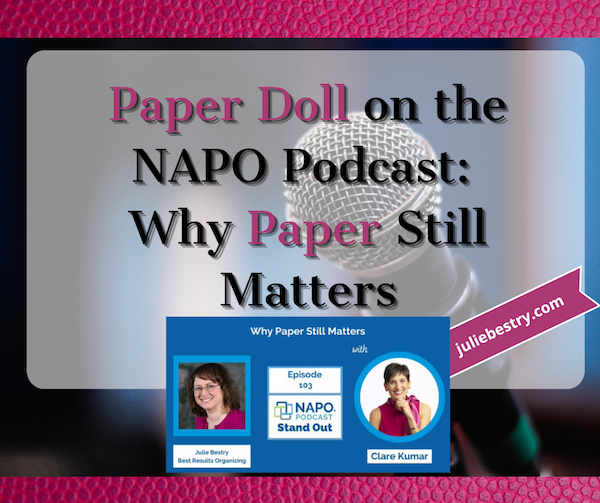
Today’s Paper Doll post is part confessional, part promotional, and part educational. But first…
Have you listened to any good podcasts lately?
I love sharing my research and philosophies of organizing and productivity here in the Paper Doll blog, but I know that sometimes it’s more convenient to listen to (or watch) material that interests you. To that end, back in May, I shared Paper Doll Picks: Organizing and Productivity Podcasts, a list of my favorite podcasts and podcasters in the realms of organizing and productivity. (If you didn’t check it out previously, now is a great time to find some new favorites!)
When I wrote Paper Doll on Planning & Prioritizing for Leadership, I even gave you a two-for-one, recommending you sign up for The Leader’s Asset, a July/August interview series I participated in, as well as sharing my interview on Dr. Frank Buck: Productivity for Total Control & Peace of Mind.
If you didn’t catch my episode, “Julie Bestry: Don’t Apologize…Organize!” the first time around, you can listen at the show link or via Apple Podcasts, Spotify, or all your usual yummy podcast hangouts. (Consider it a summer rerun.) Given the high temperatures around the country, why should you have to struggle and run clicking around the internet dial? Here’s the YouTube version.
Casting a Backward Glance
I started my business twenty years ago, the year that the federal government started prosecuting Enron, the term “Axis of Evil” was coined, and Kelly Clarkson won the first American Idol competition. I joined what was then the National Association of Professional Organizers (NAPO) in the spring of 2002.
When asked what I wanted to do with my business, I said that while I was looking forward to working one-on-one with clients to make their spaces more organized and their lives more productive, my dream project was to have my own newspaper or magazine column.
I started blogging (which is kind of like having a column) in 2007, the same year I became a Certified Professional Organizer.
Over the years, I’ve written some ebooks and had a book (now out of distribution) traditionally published.
I have also been interviewed for a variety of media outlets , including newspapers and magazines (including, I’m always delighted to say, Real Simple), as well as on local television and radio, and on the podcasts in the Paper Doll Picks poast, linked above.
But what I really want to tell you about is a particular career highlight for me.
The NAPO Stand Out Podcast (and a Case of Nerves)

NAPO is still NAPO, but now that stands for the National Association of Productivity and Organizing Professionals. (As you’ve probably noticed, the focus of Paper Doll has also expanded to include more time management and productivity topics, along with paper and information organizing posts.) Since 2018, NAPO has had its own podcast, The NAPO Stand Out Podcast.
The NAPO Stand Out podcast invites organizers, productivity experts, and related experts to share their successes, challenges, best practices, proven strategies, industry developments, and fabulous anecdotes. Of course I listen, as it’s tailor-made for someone like me.
Near the end of last year, the host of the NAPO Stand Out Podcast, my friend Clare Kumar, messaged me to see if I’d like to be on the NAPO podcast.
Clare is a Canadian professional organizer, coach, and media darling, and as I’ve mentioned on these pages before, has a laugh that completely draws you in. She specializes in helping Highly Sensitive Persons (HSPs) optimize their professional performance, and she has her own podcast, Happy Space with Clare Kumar, all about helping HSPs find their own happy spaces. Clare is a force of nature.
Now, as you longtime readers know, I’m not exactly a shrinking violet. I’m always eager to talk (until the cows come home) about residential or business organizing, time management, Evernote, and everything else from notebooks to toxic productivity.
But the NAPO Stand Out Podcast was a different kettle of fish. One of its main audiences includes thousands of my professional organizing colleagues. This wasn’t a matter of talking to strangers who follow other people’s podcasts; this would be heard and seen by my peeps, including the professional organizing rock stars to whom I’ve looked up since I started my business.
The first-ever guest was Geralin Thomas, who is as fashionable as she is business-savvy, and has pivoted to training the next generation of organizing stars. The guest the week before I was set to appear was Harold Taylor, an absolute pioneer of time management and author of numerous books, including the seminal Making Time Work for You


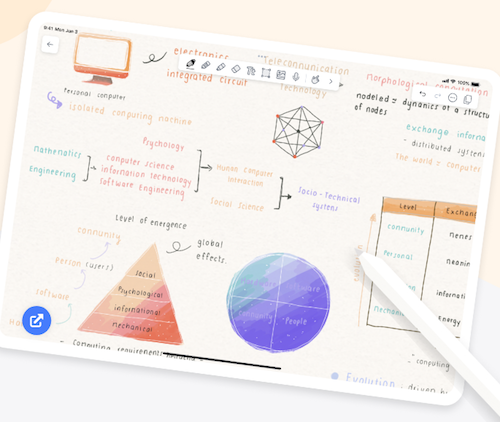
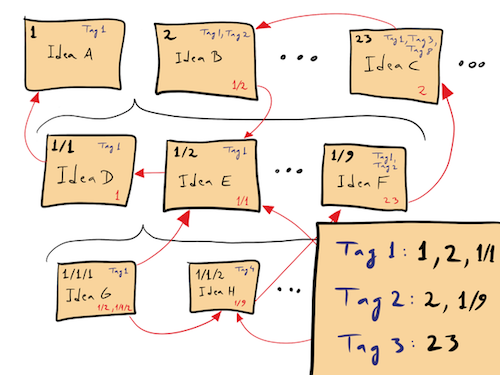




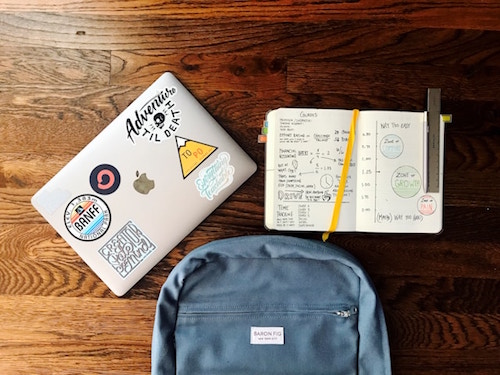
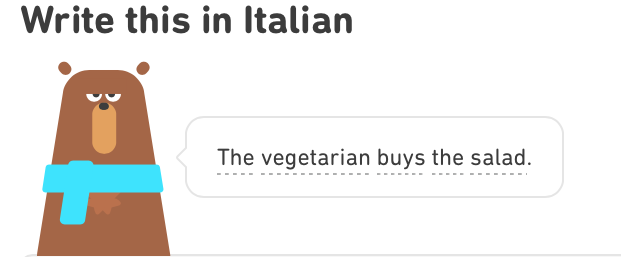



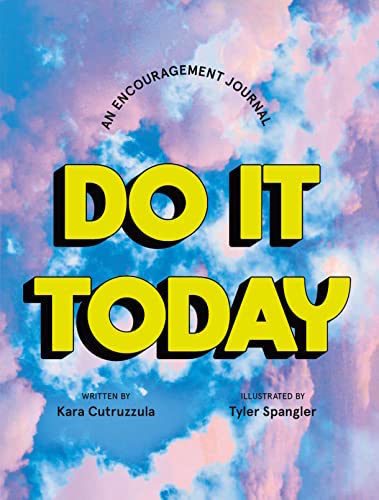





Follow Me